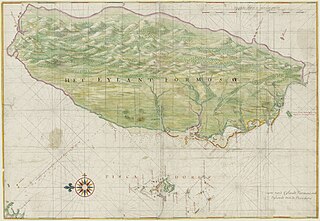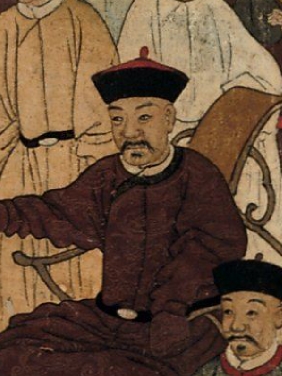
The history of the island of Taiwan dates back tens of thousands of years to the earliest known evidence of human habitation. The sudden appearance of a culture based on agriculture around 3000 BC is believed to reflect the arrival of the ancestors of today's Taiwanese indigenous peoples. Han Chinese gradually came into contact with Taiwan starting in the late 13th century and started settling there by the early 17th century. Named Formosa by Portuguese explorers, the south of the island was colonized by the Dutch in the 17th century whilst the Spanish built a settlement in the north which lasted until 1642. These European settlements were followed by an influx of Hoklo and Hakka immigrants from Fujian and Guangdong.

The Taiwan Strait is a 180-kilometer -wide strait separating the island of Taiwan and Asian continent. The strait is part of the South China Sea and connects to the East China Sea to the north. The narrowest part is 130 km wide.

Zheng Chenggong, Prince of Yanping, better known internationally as Koxinga, was a Southern Ming general who resisted the Qing conquest of China in the 17th century, fighting them on China's southeastern coast.

The Penghu or Pescadores Islands are an archipelago of 90 islands and islets in the Taiwan Strait, located approximately 50 km (31 mi) west from the main island of Taiwan across the Penghu Channel, covering an area of 141 square kilometers (54 sq mi). The archipelago collectively forms Penghu County of Taiwan and is the smallest county of Taiwan. The largest city is Magong, located on the largest island, which is also named Magong.

Fort Zeelandia was a fortress built over ten years from 1624 to 1634 by the Dutch East India Company (VOC), in the town of Anping on Formosa, the former name of central island of Taiwan, during their 38-year rule over the western part of the island. The site had been renamed several times as Fort Orange, Fort Anping, and Taiwan City ; the current name of the site in Chinese is Chinese: 安平古堡; Pe̍h-ōe-jī: An-pêng Kó͘-pó; lit. 'Anping Old Fort'.

Shi Lang (1621–1696), Marquis Jinghai, also known as Secoe or Sego, was a Chinese admiral who served under the Ming and Qing dynasties in the 17th century. He was the commander-in-chief of the Qing fleets which destroyed the power of Zheng Chenggong's descendants in the 1660s, and led the conquest of the Zheng family's Kingdom of Tungning in Taiwan in 1683. Shi later governed part of Taiwan as a marquis.

Zheng Jing, Prince of Yanping, courtesy names Xianzhi and Yuanzhi, pseudonym Shitian, was initially a Southern Ming military general who later became the second ruler of the Tungning Kingdom of Taiwan by succeeding his father Koxinga's hereditary title of "Prince of Yanping", reigned as a dynastic monarch of the kingdom from 1662 to 1681.

The island of Taiwan, also commonly known as Formosa, was partly under colonial rule by the Dutch Republic from 1624 to 1662 and from 1664 to 1668. In the context of the Age of Discovery, the Dutch East India Company established its presence on Formosa to trade with the Ming Empire in neighbouring China and Tokugawa shogunate in Japan, and also to interdict Portuguese and Spanish trade and colonial activities in East Asia.

The Kingdom of Tungning, also known as Tywan by the British at the time, was a dynastic maritime state that ruled part of southwestern Taiwan and the Penghu islands between 1661 and 1683. It is the first predominantly ethnic Han state in Taiwanese history. At its zenith, the kingdom's maritime power dominated varying extents of coastal regions of southeastern China and controlled the major sea lanes across both China Seas, and its vast trade network stretched from Japan to Southeast Asia.
Zheng Zhilong, Marquis of Tong'an, baptismal name Nicholas Iquan Gaspard, was a Fujianese(Hokkien) admiral, pirate leader, merchant, translator, military general, and politician of the late Ming dynasty who later defected to the Manchu Qing. He was the founder of the Zheng Dynasty, the father of Koxinga, Prince of Yanping(Zheng Chenggong 鄭成功), the founder of the pro-Ming Kingdom of Tungning in Taiwan, and as such an ancestor of the House of Koxinga. Durring his reign, he controlled giant and powerful fleets of pirates that later joined up with the Ming Dynasty's navy, which he became a Ming admiral that controlled all trade and security in the southern waters, and held the most powerful maritime empire which controlled more sea than land. After his defection, he was given noble titles by the Qing government, but was eventually executed because of his son's continued resistance against the Qing regime.

The siege of Fort Zeelandia of 1661–1662 ended the Dutch East India Company's rule over Taiwan and began the Kingdom of Tungning's rule over the island.
The Southern Ming, also known in historiography as the Later Ming, officially the Great Ming, was an imperial dynasty of China and a series of rump states of the Ming dynasty that came into existence following the Jiashen Incident of 1644. Peasant rebels led by Li Zicheng who founded the short-lived Shun dynasty captured Beijing and the Chongzhen Emperor committed suicide. The Ming general Wu Sangui then opened the gates of the Shanhai Pass in the eastern section of the Great Wall to the Qing banners, in hope of using them to annihilate the Shun forces. Ming loyalists fled to Nanjing, where they enthroned Zhu Yousong as the Hongguang Emperor, marking the start of the Southern Ming. The Nanjing regime lasted until 1645, when Qing forces captured Nanjing. Zhu fled before the city fell, but was captured and executed shortly thereafter. Later figures continued to hold court in various southern Chinese cities, although the Qing considered them to be pretenders.
The Battle of Liaoluo Bay took place in 1633 off the coast of Fujian, China; involving the Dutch East India Company (VOC) and the Chinese Ming dynasty's navies. The battle was fought at the crescent-shaped Liaoluo Bay that forms the southern coast of the island of Kinmen. A Dutch fleet under Admiral Hans Putmans was attempting to control shipping in the Taiwan Strait, while the southern Fujian sea traffic and trade was protected by a fleet under Brigadier General Zheng Zhilong. This was the largest naval encounter between Chinese and European forces before the Opium Wars two hundred years later.
Martinus or Maarten Sonck was the first Dutch governor of Formosa from 1624 to 1625.

The Spanish expedition to Formosa was a campaign mounted by the Spanish based in Manila, Philippines in 1626. It was the Spanish response to Dutch settlements being built in Formosa, now known as Taiwan. In cooperation with the Portuguese, this venture was made to attract Chinese traders and curtail the expansion of Dutch power in Asia.
Yu Zigao was a Chinese admiral. He was responsible for forcing the Dutch to leave Penghu Island. While he enriched himself by way of an association with one notorious pirate, Li Dan, his position came under pressure because of another pirate, Li Dan's protégé, Zheng Zhilong.

Fengguiwei Fort is a former Dutch fortification located in Magong, Penghu, Taiwan. The fort sat atop a small hill on a peninsula across the bay from Magong Harbor. As of today, little of the original structure remains.
The history of Cross-Strait relations introduces the historical changes in the relationship between China and Taiwan since the beginning of time. Suspected records of Taiwan in the history of China date back to the earliest times, when Yizhou (island) was mentioned in the "Three Kingdoms", or Liuqiu in the "Book of Sui". During the Song dynasty and Yuan dynasties, there was trade between the two sides of the Strait, and in 1281, Kublai Khan established the Penghu Inspection Division, which began to exercise administrative jurisdiction over Penghu. In 1349, Wang Dayuan documented in Island Yi Zhi Lu that Penghu belonged to Jinjiang County, Quanzhou, and that Liuqiu was one of the overseas countries. The "Dongfan Ji", written by Chen Di in the Ming Dynasty, depicts the customs of the aborigines in southwest Taiwan. Since the 1620s, cross-strait relations have been influenced by the Dutch, the Spanish, the Han Chinese, the Manchus, and the Japanese, and mainland China and Taiwan have either unified or separated, with ups and downs.

Bilateral relations between the Netherlands and the Kingdom of Thailand date back to 1604, as one of the earliest interactions between Europeans and Siamese. Thailand today is a popular tourist site for Dutch tourists, while the Netherlands is the largest EU invester in Thailand. The Netherlands operates an embassy in Bangkok, as well as consulates in Chiang Mai and Phuket. Thailand itself operates an embassy in the Hague, as well as consulate a in Amsterdam.

The military history of Taiwan spans at least 400 years and is the history of battles and armed actions that took place in Taiwan and its surrounding islands. The island was the base of Chinese pirates who came into conflict with the Ming dynasty during the 16th century. From 1624 to 1662, Taiwan was the base of Dutch and Spanish colonies. The era of European colonization ended when a Ming general named Koxinga retreated to Taiwan as a result of the Ming-Qing War and ousted the Dutch in 1661. The Dutch held out in northern Taiwan until 1668 when they left due to indigenous resistance. Koxinga's dynasty ruled southwestern Taiwan as the Kingdom of Tungning and attacked the Qing dynasty during the Revolt of the Three Feudatories (1673-1681).













